About the Church
 |
 |
 |
 |
 |
 |
 |
The Holy Mass - Part XV
The Communion in the Holy Mass
Before Vatican II, as noted in the last article, the kiss of peace was only given at the solemn High Mass, exchanged by the priest and deacon(s) on the altar. It preceded the solemn, recollected Prayers before Communion, which started with the prayer for peace:

When we compare this prayer, which is meant to prepare both the priest and faithful to partake of the holy mysteries, with the raucous “kiss of peace” introduced after Vatican II, we see how disruptive the latter is to the proper spirit of the Mass.
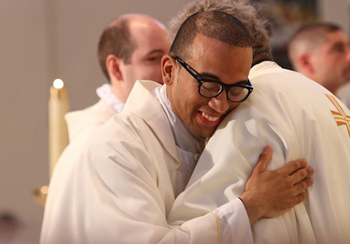
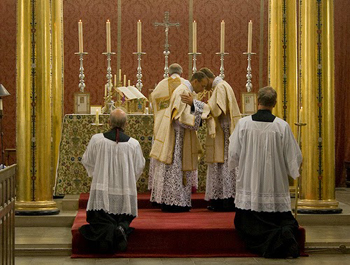 We are often reminded in Mass instructions of times past that the faithful should take special care not to speak or laugh with others, or even to rise from their knees without urgent cause from the time of the Consecration until the Communion. (1)
We are often reminded in Mass instructions of times past that the faithful should take special care not to speak or laugh with others, or even to rise from their knees without urgent cause from the time of the Consecration until the Communion. (1)
Instead of calling us to a serious preparation to receive the Body and Blood of Our Lord Jesus Christ, the modern “kiss of peace” – which includes getting up, shaking hands, saying hello, giving hugs and even kissing – disturbs recollection and breaks reverence. Mass is transformed into a social celebration of the community, a preparation for a meal rather than the Sacrifice of the Cross.
In the Tridentine Mass of all times there is no such agitation and disturbance. The priest goes on to recite two other beautiful prayers before the Communion.
Domine Iesu Christe ... is a profound plea for three things made to the Lord Who we will receive shortly: first,that we may be forgiven for our sins; second, that we may be faithful to His Law, and third, that we may not be separated from Him, now and forever. Here is truly where the mind and heart should be focused, not on a hippie-like love fest of hugs and joy.
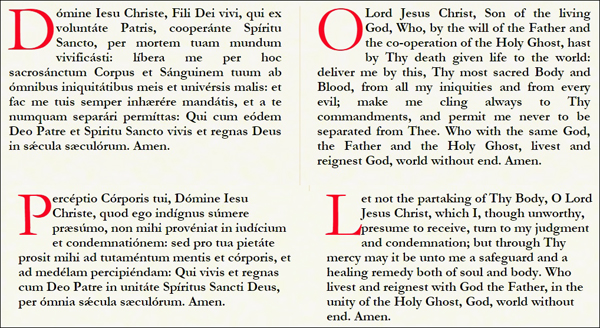
The third prayer Perceptio Corporis tui refers again to the Sacrifice, reminding that it is to be approached with humility and holy fear. Here the priest asks – and we unite our prayer with his – that we might be preserved from making an unworthy Communion. With this petition the fearful words of St. Paul come to mind: "For he that eateth and drinketh unworthily, eateth and drinketh judgment to himself, not discerning the body of the Lord." (1 Cor 11:29)
Domine non sum dignus
Now the priest genuflects, takes the Sacred Host in his left hand and makes the exclamation of praise Panem caelestem... These words are taken partly from Psalm 115, which was a fervent prayer of thanksgiving and praise for the Jew's liberation from the Babylonian exile. It is as if to say "I will receive the bread of Heaven while praising the name of the Lord."

Bowing before the altar, humbly striking his breast three times (the bell is rung thrice), the priest now repeats the word of the centurion of Capharnaum (Mt 8:8):

The Church has given this episode of the humility of a Gentile a glorious and lasting memorial, teaching us to approach the holy altar rail with the same humility, trust in God and faith as the centurion, and we will be rewarded as he was.
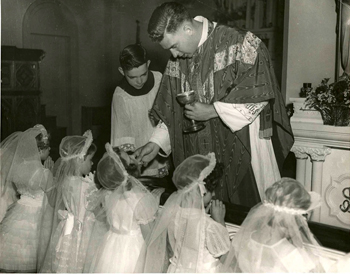 Holding the two halves of the Sacred Host in his right hand, the priest makes the Sign of the Cross with them and says: "Corpus domini nostri Jesu Christi custodiat animam meam in vitam aeternam. Amen" (May the Body of Our Lord Jesus Christ preserve my soul unto life eternal). He, then, reverently consumes the Sacred Body of Our Lord.
Holding the two halves of the Sacred Host in his right hand, the priest makes the Sign of the Cross with them and says: "Corpus domini nostri Jesu Christi custodiat animam meam in vitam aeternam. Amen" (May the Body of Our Lord Jesus Christ preserve my soul unto life eternal). He, then, reverently consumes the Sacred Body of Our Lord.
After a moment of recollection, he uncovers the chalice and puts in it the small particles of Host that may have adhered to the Corporal and Paten, saying these words Quid retribuam Domino...
What return shall we make to the Lord?
These words, overflowing with gratitude, express the priest's realization of his own unworthiness to effect the Holy Sacrament. The answer to the question is immediate: The proper way to show thanks is to receive Our Lord's own gift to us.
Taking the chalice in his right hand and making the Sign of the Cross with the chalice itself, he says Sanguis Domini nostri... and receives the Precious Blood of Christ.

Communion of the Faithful
Now is the proper time for the communication of the faithful, if any approach to receive the Sacred Species. This point is worth emphasizing, since many Catholics today, infected with the novel progressivist teaching inspired by the New Liturgy, have the notion that it is essential for the faithful to participate at a Mass and that the priest and people must join together to receive Communion for the Mass to be complete.
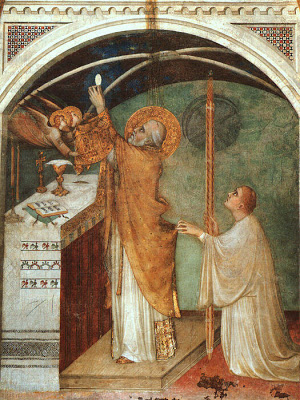 This notion that an active participation of the faithful is necessary is absolutely false and dangerous, as has been pointed out in the excellent series posted on this site by Dr. Carol Byrne. The Mass has an infinite value with or without the presence of the faithful, with or without the faithful communicating.
This notion that an active participation of the faithful is necessary is absolutely false and dangerous, as has been pointed out in the excellent series posted on this site by Dr. Carol Byrne. The Mass has an infinite value with or without the presence of the faithful, with or without the faithful communicating.
It is because of the infinite value of the Mass, which renders a means to compensate for many sins and offenses, that the faithful should in fact approach the altar as often as possible.
St. Lawrence Justinian confirms this when he says: "Take a pair of scales, and place on one scale all manner of good works – prayers, fasts, vigils, mortifications, pilgrimages and what not. On the other scale place one single Mass.
"Hold up your scales and you will see how entirely the latter outweighs the former, for in the Mass He is offered in Whom dwelleth all the fullness of the Godhead." (2)
Before the distribution of Holy Communion, the Confiteor is recited by the deacon on behalf of the people.
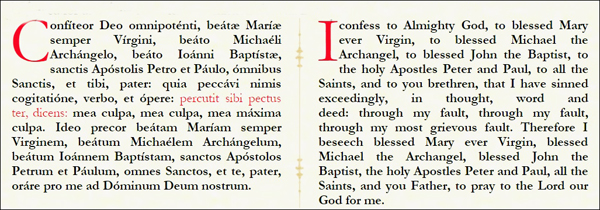
Absolution of venial sins
After the Confiteor, the priest turns and says: Miseratur vestri ominpotens Deus... All present join with the priest in making the Sign of the Cross. Then he says: Indulgentiam, absolutionem, et remissionem ...
Some persons have asked if at this point in the Latin rite the priest gives a general absolution. The answer is no.

If the priest were giving sacramental absolution, he would say "I absolve you of your sins, in the name of the Father, and of the Son and of the Holy Ghost." The formula recited before Communion is "deprecatory": It asks God to forgive our sins if He is willing, but it is not an exercise of the priest's authority to forgive them himself.
As a blessing and sacramental, it takes away venial sins. It does not forgive the sins of those who are in the state of mortal sin and have not made a sacramental Confession. Then, turning to the people and holding up the Host, the priest says, Ecce Agnus Dei...
Then, he says three times aloud the words he said quietly before: Dominue, non sum dignus...

The priest gives the Blessed Sacrament to each one of those who are at the altar rail. They receive the Host on the tongue and kneeling. He makes a Sign of the Cross with the Host and says:

Worthy reception of the King of Kings
It is imperative here to speak of a matter of growing concern, which is the proper attire at the Holy Mass. When we go to the altar of Our Lord, we come before the King of Kings, the Creator and Master of the universe.
No words need be said about the deteriorating attire of men and women in the Novus Ordo Masses, where dress is as casual as what is worn at a picnic or sports event. What deserves a word is the increasingly casual and immodest dress we are seeing at traditional Masses.
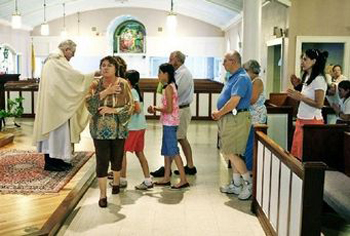
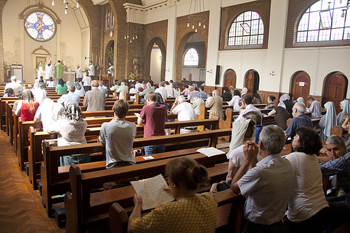 We point out here not just the immodesty of women who wear tank tops, tops with plunging necklines, skin-tight skirts - some far above the knee, others below with long slits that reveal the thigh. Such clothing objectively presents an occasion of sin for the men in the church.
We point out here not just the immodesty of women who wear tank tops, tops with plunging necklines, skin-tight skirts - some far above the knee, others below with long slits that reveal the thigh. Such clothing objectively presents an occasion of sin for the men in the church.
Even more disconcerting is the dress of men, who are appearing in casual pants or shorts, blue jeans, open collared shirts, tennis shoes, and so on – all the casual dress of our days. Twenty or 30 years ago, there was not a man at a traditional Mass who was not without his suit jacket, tie and dress pants and shoes. Why? Not from vanity, but out of respect for Our Lord, whom he believed to be truly present in the Tabernacle.
Let the reader reflect on this true story that took place with the famous 17th century French bishop and theologian Bossuet, renowned for his oratory skills. Then, let him consider if his own appearance at Mass does in fact reflect his belief in the Real Presence.
Bossuet was involved in a long discussion with a Protestant named Claude. One day, the latter observed Bossuet leaving the Cathedral of Meaux hurriedly with several buttons from his cassock missing.
"Monsignor," remarked Claude, "you do not really believe in the presence of God in your church."
"But assuredly, I do believe," Bossuet answered indignantly.
"Monsignor," Claude replied, "if you truly believed, you would not appear before your God with your cassock in disarray."
A living faith must be shown in a man's attitude and appearance before the altar, comments Fr. Almire Pichon after relating this episode. (3) You are in the presence of your King – your Divine Captive. Our Lord desires to be treated like God, the King of Kings.
Continued


When we compare this prayer, which is meant to prepare both the priest and faithful to partake of the holy mysteries, with the raucous “kiss of peace” introduced after Vatican II, we see how disruptive the latter is to the proper spirit of the Mass.

Priests jovially embrace on the altar at a New Mass; below, the traditional kiss of peace at a High Mass

Instead of calling us to a serious preparation to receive the Body and Blood of Our Lord Jesus Christ, the modern “kiss of peace” – which includes getting up, shaking hands, saying hello, giving hugs and even kissing – disturbs recollection and breaks reverence. Mass is transformed into a social celebration of the community, a preparation for a meal rather than the Sacrifice of the Cross.
In the Tridentine Mass of all times there is no such agitation and disturbance. The priest goes on to recite two other beautiful prayers before the Communion.
Domine Iesu Christe ... is a profound plea for three things made to the Lord Who we will receive shortly: first,that we may be forgiven for our sins; second, that we may be faithful to His Law, and third, that we may not be separated from Him, now and forever. Here is truly where the mind and heart should be focused, not on a hippie-like love fest of hugs and joy.

The third prayer Perceptio Corporis tui refers again to the Sacrifice, reminding that it is to be approached with humility and holy fear. Here the priest asks – and we unite our prayer with his – that we might be preserved from making an unworthy Communion. With this petition the fearful words of St. Paul come to mind: "For he that eateth and drinketh unworthily, eateth and drinketh judgment to himself, not discerning the body of the Lord." (1 Cor 11:29)
Domine non sum dignus
Now the priest genuflects, takes the Sacred Host in his left hand and makes the exclamation of praise Panem caelestem... These words are taken partly from Psalm 115, which was a fervent prayer of thanksgiving and praise for the Jew's liberation from the Babylonian exile. It is as if to say "I will receive the bread of Heaven while praising the name of the Lord."

Bowing before the altar, humbly striking his breast three times (the bell is rung thrice), the priest now repeats the word of the centurion of Capharnaum (Mt 8:8):

The Church has given this episode of the humility of a Gentile a glorious and lasting memorial, teaching us to approach the holy altar rail with the same humility, trust in God and faith as the centurion, and we will be rewarded as he was.

A priest gives First Communion at a pre-Vatican II Mass
After a moment of recollection, he uncovers the chalice and puts in it the small particles of Host that may have adhered to the Corporal and Paten, saying these words Quid retribuam Domino...
What return shall we make to the Lord?
These words, overflowing with gratitude, express the priest's realization of his own unworthiness to effect the Holy Sacrament. The answer to the question is immediate: The proper way to show thanks is to receive Our Lord's own gift to us.
Taking the chalice in his right hand and making the Sign of the Cross with the chalice itself, he says Sanguis Domini nostri... and receives the Precious Blood of Christ.

Communion of the Faithful
Now is the proper time for the communication of the faithful, if any approach to receive the Sacred Species. This point is worth emphasizing, since many Catholics today, infected with the novel progressivist teaching inspired by the New Liturgy, have the notion that it is essential for the faithful to participate at a Mass and that the priest and people must join together to receive Communion for the Mass to be complete.

The infinite value of the Holy Mass, with or without the faithful present
It is because of the infinite value of the Mass, which renders a means to compensate for many sins and offenses, that the faithful should in fact approach the altar as often as possible.
St. Lawrence Justinian confirms this when he says: "Take a pair of scales, and place on one scale all manner of good works – prayers, fasts, vigils, mortifications, pilgrimages and what not. On the other scale place one single Mass.
"Hold up your scales and you will see how entirely the latter outweighs the former, for in the Mass He is offered in Whom dwelleth all the fullness of the Godhead." (2)
Before the distribution of Holy Communion, the Confiteor is recited by the deacon on behalf of the people.

Absolution of venial sins
After the Confiteor, the priest turns and says: Miseratur vestri ominpotens Deus... All present join with the priest in making the Sign of the Cross. Then he says: Indulgentiam, absolutionem, et remissionem ...
Some persons have asked if at this point in the Latin rite the priest gives a general absolution. The answer is no.

If the priest were giving sacramental absolution, he would say "I absolve you of your sins, in the name of the Father, and of the Son and of the Holy Ghost." The formula recited before Communion is "deprecatory": It asks God to forgive our sins if He is willing, but it is not an exercise of the priest's authority to forgive them himself.
As a blessing and sacramental, it takes away venial sins. It does not forgive the sins of those who are in the state of mortal sin and have not made a sacramental Confession. Then, turning to the people and holding up the Host, the priest says, Ecce Agnus Dei...
Then, he says three times aloud the words he said quietly before: Dominue, non sum dignus...

The priest gives the Blessed Sacrament to each one of those who are at the altar rail. They receive the Host on the tongue and kneeling. He makes a Sign of the Cross with the Host and says:

Worthy reception of the King of Kings
It is imperative here to speak of a matter of growing concern, which is the proper attire at the Holy Mass. When we go to the altar of Our Lord, we come before the King of Kings, the Creator and Master of the universe.
No words need be said about the deteriorating attire of men and women in the Novus Ordo Masses, where dress is as casual as what is worn at a picnic or sports event. What deserves a word is the increasingly casual and immodest dress we are seeing at traditional Masses.

The casual dress at Novus Ordo Masses is increasingly present at the Latin Mass, below

Even more disconcerting is the dress of men, who are appearing in casual pants or shorts, blue jeans, open collared shirts, tennis shoes, and so on – all the casual dress of our days. Twenty or 30 years ago, there was not a man at a traditional Mass who was not without his suit jacket, tie and dress pants and shoes. Why? Not from vanity, but out of respect for Our Lord, whom he believed to be truly present in the Tabernacle.
Let the reader reflect on this true story that took place with the famous 17th century French bishop and theologian Bossuet, renowned for his oratory skills. Then, let him consider if his own appearance at Mass does in fact reflect his belief in the Real Presence.
Bossuet was involved in a long discussion with a Protestant named Claude. One day, the latter observed Bossuet leaving the Cathedral of Meaux hurriedly with several buttons from his cassock missing.
"Monsignor," remarked Claude, "you do not really believe in the presence of God in your church."
"But assuredly, I do believe," Bossuet answered indignantly.
"Monsignor," Claude replied, "if you truly believed, you would not appear before your God with your cassock in disarray."
A living faith must be shown in a man's attitude and appearance before the altar, comments Fr. Almire Pichon after relating this episode. (3) You are in the presence of your King – your Divine Captive. Our Lord desires to be treated like God, the King of Kings.
Continued
- Martin von Cochem, Explanation of the Holy Sacrifice of the Mass, NY: Benzinger Bros., 1896, m p 357
- Ibid., p. 213
- Seeds of the Kingdom, Newman Press, 1961, reprinted by Lepanto Press (www.olvs.org), pp. 40-41.

Posted November 16, 2018















